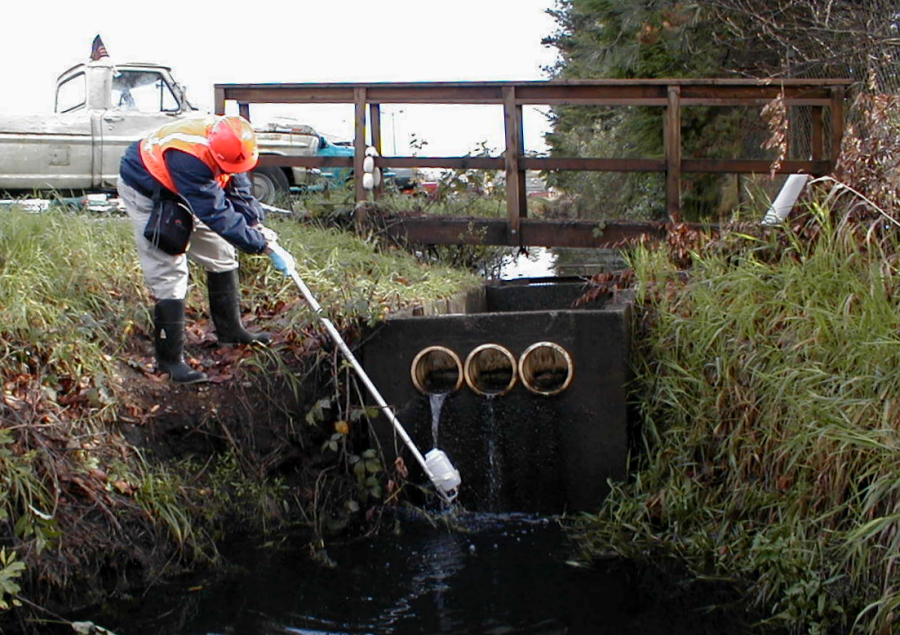
“If you didn’t document it, it didn’t happen.” It’s an old saying that many believe to be true. The scientists in our Environmental Assessment Program do a lot of documenting.
We generate nearly a hundred scientific documents every year. We have a library containing thousands of publications written by oceanographers, chemists, statisticians, and more. All of our documents are available free to the public. Below is a list of the five most popular publications from our Environmental Assessment Program. Warning: These are not light reading.
1) Puget Sound Nutrient Source Reduction Project. Volume 1: Model Updates and Bounding Scenarios
This is our most-read publication, with just under 1,300 views in the last year. In this report, our scientists evaluated changes in marine dissolved oxygen and its relationship to nutrients, especially nitrogen, discharged from wastewater treatment plants. Using the Salish Sea Model, they tested a number of scenarios to measure the impacts of reducing nitrogen and carbon (affecting pH) in places throughout the Puget Sound and Salish Sea.
Excessive nutrients flowing into marine waters can lead to profound consequences for the ecosystem. In addition to low levels of oxygen, some effects include:
- Acidification, which can prevent shellfish and other marine organisms from forming shells
- Shifts in the number and types of bottom-dwelling invertebrates
- Increases in abundance of macroalgae, which can impair the health of eelgrass beds
- Seasonal reductions in fish habitat and intensification of fish kill events
- Potential disruption of the food web
https://fortress.wa.gov/ecy/publications/SummaryPages/1903001.html
2) A Water Quality Index for Ecology's Stream Monitoring Program
Our second most-read publication, with 1,219 views in the last year, attempts to provide an understandable, layman-friendly index for non-scientists to learn about water quality in Washington’s streams. The index uses a scale of one to 100 with higher numbers representing higher water quality.
The document was intended for use by political decision-makers, non-technical water managers, and the general public who “usually have neither the time nor the training to study and understand a traditional, technical review of water quality data.”
https://fortress.wa.gov/ecy/publications/SummaryPages/0203052.html
3) Stormwater Sampling Manual: A Guide for the Industrial Stormwater General Permit
The third most-read item on our list, with 659 views in the last year, was written by our scientists for those who manage industrial facilities that discharge stormwater to a surface water body or to a storm sewer system that drains to a surface water body. Sources of pollutants that may enter surface water, sediments, or groundwater can be identified by sampling stormwater discharges. The purpose of this manual is to help those who operate facilities do their own sampling by providing step-by-step procedures of what facilities need to do to sample, gather, and report data in order to describe the quality of stormwater leaving the facility.
https://fortress.wa.gov/ecy/publications/SummaryPages/1503044.html
4) Procedure Manual for the Environmental Laboratory Accreditation Program
Sitting at number four, with 578 views in the last year, this manual explains procedures for implementing the Washington state Environmental Laboratory Accreditation Program. The manual provides guidance to laboratories participating in the program and to users of data from these laboratories. Washington accreditation is required for any lab that wants to report data to the state of Washington.
About 400 labs in Washington receive regular visits from our Laboratory Accreditation Unit (LAU). Accreditation is renewed every year, with audits taking place every three years.
In the accreditation process, our LAU scientists verify a lab’s capabilities to do the analyses they’re accredited for and ensure they have the quality assurance procedures in place to verify their data and understand the methods that are required.
https://fortress.wa.gov/ecy/publications/SummaryPages/1003048.html
5) Guidelines for Preparing Quality Assurance Project Plans for Environmental Studies
Credible science requires quality assurance. This document, with 558 views in the last year, ensures that happens by outlining the procedures necessary to ensure quality work when collecting, storing, and testing samples in the field or the lab.
It’s not just a document for our own scientists. It provides guidance for environmental science grantees, including those receiving grants from the National Estuary Program who need to submit a Quality Assurance Project Plan before beginning work.
Our quality assurance documents are based on policies and guidance from the U.S. Environmental Protection Agency.
https://fortress.wa.gov/ecy/publications/SummaryPages/0403030.html
This is just a small sample of the wide range of scientific information available in our publications database. To see more visit https://fortress.wa.gov/ecy/publications/UIPages/SearchPublications.aspx.





